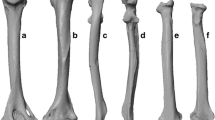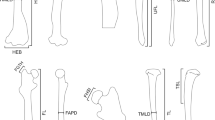Abstract
The potential for making functional interpretations from a single postcranial element for marsupials was investigated through morphometric analysis of the calcanea of 61 extant species from Australia and New Guinea. Extant species were grouped into locomotor categories and a canonical variates analysis was carried out on measurements of their calcanea. A relationship between measurements of the calcanea and the locomotor behavior of species was found, allowing for prediction of locomotor behavior from calcaneum morphometrics. This was applied to fossil marsupial taxa, from early–late Miocene/?Pliocene deposits at Riversleigh, in an attempt to determine their locomotor behavior. Hopping (saltatorial) taxa are distinguished from quadruped terrestrial taxa and taxa capable of climbing (arboreal and scansorial) by their relatively longer tuber calcis and wider calcaneal head, by their dorso-ventrally thicker calcaneal head, and by their calcaneocuboid facet being less steeply angled antero-posteriorly. Taxa capable of climbing are distinguished from quadruped terrestrial taxa by their shorter tuber calcis relative to the calcaneal head and by their smaller calcaneo-astragalar facet. The locomotor categories distinguished in this study (arboreal/scansorial, quadruped terrestrial, and saltatorial) highlight differences between species in their use of available substrates and thus are informative with regards to the structural components of their habitat. The results of this analysis can be used, in combination with other data, to make inferences about the habitats of paleocommunities at Riversleigh through the Miocene. The calcaneum is a dense and very robust element and, therefore, has a good chance of being preserved. This method provides a quick and easy way of inferring locomotion and has a wide potential for application to many fossil deposits because it requires only a single element.




Similar content being viewed by others
References
Archer M, Godthelp H, Hand SJ, Megirian D (1989) Fossil mammals of Riversleigh, northwestern Queensland: preliminary overview of biostratigraphy, correlation and environmental change. Aust Zool 25:29–65
Archer M, Hand SJ, Godthelp H, Creaser P (1997) Correlation of the Cainozoic sediments of the Riversleigh World Heritage Fossil Property, Queensland, Australia. In: Aguilar JP, Legendre S, Michaux J (eds) Actes du Congress BiochroM’97. Mem Trav EPHE, Inst Monpellier, pp 131–152
Argot C (2001) Functional–adaptive anatomy of the forelimb in the Didelphidae, and the paleobiology of the Paleocene marsupials Mayulestes ferox and Pucadelphys andinus. J Morphol 247:51–79. doi:10.1002/1097-4687(200101)247:1<51::AID-JMOR1003>3.0.CO;2-#
Argot C (2002) Functional–adaptive analysis of the hindlimb anatomy of extant marsupials and the paleobiology of the Paleocene marsupials Mayulestes ferox and Pucadelphys andinus. J Morphol 253:76–108 doi:10.1002/jmor.1114
Bertram JEA, Biewener AA (1990) Differential scaling in the long bones in the terrestrial Carnivora and other mammals. J Morphol 220:157–169 doi:10.1002/jmor.1052040205
Bishop N (1997) Functional anatomy of the macropodid pes. Proc Linn Soc N S W 117:17–50
Cartmill M (1985) Climbing. In: Hildelbrand M, Bramble DM, Liem KF, Wake DB (eds) Functional Vertebrate Morphology. Belknap, Cambridge MA, pp 73–88
Creaser P (1997) Oligocene–Miocene sediments of Riversleigh: the potential significance of topography. Mem Queensl Mus 41:303–314
Damuth JD (1992) Taxon-free characterization of animal communities. In: Behrensmeyer AK, Damuth JD, Di Michele WA, Potts R, Sues H-D, Wing SL (eds) Terrestrial Ecosystems Through Time. The University of Chicago Press, Chicago, pp 183–203
Fa-Hong Y, Yan-Zhang P, Ru-Liang P, Zhi-Zhang Y, Hong W (1993) Comparative studies on ankle joints in quadriceps. Acta Zool Sin 39:424–430
Flannery TF (1995) Mammals of New Guinea. Reed Books, Sydney
Flannery TF, Martin R, Szalay A (1996) Tree Kangaroos—A Curious Natural History. Reed Books, Victoria
Gordon G (1998) Northern brown bandicoot, Isoodon macrourus (Gould, 1842). In: Strahan R (ed) The Mammals of Australia. New Holland, Sydney, pp 174–175
Hair JF, Anderson RE, Tatham RL, Black WC (1998) Multivariate Data Analysis. Prentice-Hall, USA
Hall RL, Shereff MJ (1993) Anatomy of the calcaneus. Clin Orthop Relat Res 290:27–35
Hammer Ø, Harper DAT, Ryan PD (2004) PAST—PAlaeontological STatistics, Version 1.27. Computer program available online at http://folk.uio.no/ohammer/past
Hickman CS (1988) Analysis of form and function in fossils. Am Zool 28:775–793
Janis CM, Theodor JM, Boisvert B (2002) Locomotor evolution in camels revisited: a quantitative analysis of pedal anatomy and the acquisition of the pacing gait. J Vertebr Paleontol 22:110–121 doi:10.1671/0272-4634(2002)022[0110:LEICRA]2.0.CO;2
Jenkins FA Jr (1974) Tree shrew Locomotion and the origins of primate arborealism. In: Jenkins FA Jr (ed) Primate Locomotion. Academic, New York, pp 85–115
Jenkins FA Jr, McLearn D (1984) Mechanisms of hind foot reversal in climbing mammals. J Morphol 182:197–219 doi:10.1002/jmor.1051820207
Lemelin P (1999) Morphological correlates of substrate use in didelphid marsupials: implications for primate origins. J Zool (Lond) 247:165–175 doi:10.1111/j.1469-7998.1999.tb00980.x
Oxnard CE (1968) The architecture of the shoulder in some mammals. J Morphol 126:249–290 doi:10.1002/jmor.1051260302
Paddle R (2000) The Last Tasmanian Tiger—The History and Extinction of the Thylacine. Cambridge University Press, Cambridge
Reyment RA, Blackith RE, Campbell NA (1984) Multivariate Morphometrics. Academic, London
Sarrafian SK (1993) Biomechanics of the subtalar joint complex. Clin Orthop Relat Res 290:17–26
Strahan R (ed) (1998) The Mammals of Australia. New Holland, Sydney
SYSTAT—Version 7.0 for Windows (1997) SPSS, Chicago (computer program)
Szalay FS (1982) A new appraisal of marsupial phylogeny and classification. In: Archer M (ed) Carnivorous Marsupials. Royal Zoological Society of New South Wales, Australia, pp 621–640
Szalay FS (1994) Evolutionary History of the Marsupials and an Analysis of Osteological Characters. Cambridge University Press, Cambridge
Szalay FS, Decker RL (1974) Origins, evolution and function of the tarsus in late Cretaceous eutherians and Paleocene primates. In: Jenkins FA Jr (ed) Primate Locomotion. Academic, New York, pp 233–259
Szalay FS, Sargis EJ (2001) Model-based analysis of postcranial osteology of marsupials from the Palaeocene of Itaborai (Brazil) and the phylogenetics and biogeography of Metatheria. Geodiversitas 23:139–302
Turbón D, Pérez-Pérez A, Springer CB (1997) A multivariate analysis of Pleistocene hominids: testing hypotheses of European origins. J Hum Evol 32:449–468 doi:10.1006/jhev.1996.0119
Van Valkenburgh B (1987) Skeletal indicators of locomotor behavior in living and extinct carnivores. J Vertebr Paleontol 7:162–182
Walker A (1974) Locomotor adaptations in past and present prosimian primates. In: Jenkins FA Jr (ed) Primate Locomotion. Academic, New York, pp 349–381
Wells RG (1989) Vombatidae. In: Walton DW, Richardson BJ (eds) Fauna of Australia, vol 1B Mammalia. Australian Government Publishing Service, Canberra, pp 755–768
Youlatos D (2003) Calcaneal features of the Greek Miocene primate Mesopithecus pentelicus (Cercopithecoidea: Colobinae). Geobios 36:229–239 doi:10.1016/S0016-6995(03)00008-1
Acknowledgements
Vital support for the Riversleigh Fossil Project has been provided by the Australian Research Council, Department of Environment and Heritage, Environment Australia, the University of New South Wales, the Queensland Museum, the Australian Museum, Mount Isa City Council, Outback at Isa, Xstrata, CREATE, and many private supporters and volunteers as well as staff and postgraduate students of the University of New South Wales. We thank D. Arena R. Beck, K. Black, P. Brewer, A. Gillespie, H. Godthelp, S. Hand, B. Kear, J. Louys, K. Roberts, K. Travouillon, and V. Weisbecker for discussion, technical advice and assistance. T. Ennis and S. Ingleby kindly allowed access to comparative specimens at the Australian Museum.
Author information
Authors and Affiliations
Corresponding author
Appendices
Appendix A: Calcaneal measurements (mm) for modern marsupial species represented by more than one specimen
Appendix B: Raw calcaneal measurements for modern marsupial species represented by single specimens (mm)
Appendix C: Modern marsupial calcaneal measurements for species used as ‘unknowns’ in analysis (mm)
Appendix D: Raw calcaneal measurements for fossil marsupials (in mm; where more than one specimen represents a morphotype, average values are given)
Rights and permissions
About this article
Cite this article
Bassarova, M., Janis, C.M. & Archer, M. The Calcaneum—On the Heels of Marsupial Locomotion. J Mammal Evol 16, 1–23 (2009). https://doi.org/10.1007/s10914-008-9093-7
Published:
Issue Date:
DOI: https://doi.org/10.1007/s10914-008-9093-7




